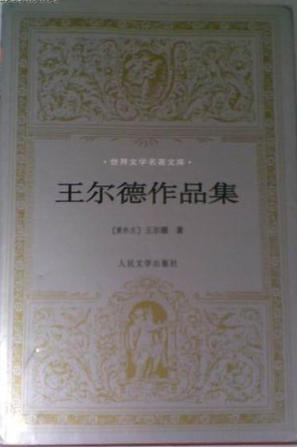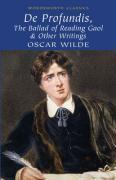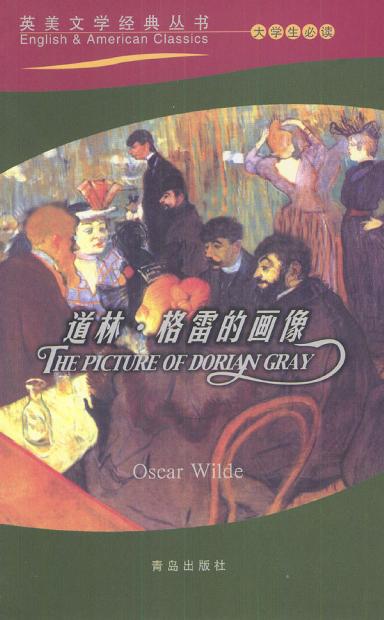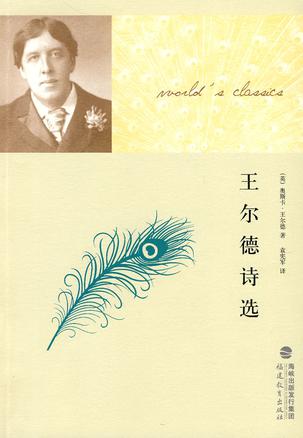欢迎来到相识电子书!
标签:OscarWilde
-
The Picture of Dorian Gray
A young man of rare beauty, Dorian Gray is the very picture of the ideal British gentleman. When he is drawn into a life of decadence and lustful indulgence, he discovers a painting begins to bear new marks for each of his sins, leaving him as youthful and attractive as ever. And so begins Dorian's descent into a personal hell of lies, murder, and depravity. -
王尔德作品集
本书收有:《道连·格雷的画像》(小说)、《一个无关紧要的女人》(戏剧)、《自深深处》(论说文)、《雷丁监狱的歌》(诗歌)等8篇作品。 -
奥斯卡·王尔德
本书系《剑桥文学指南》丛书中的一种,是一部专门研究王尔德的论文集,收录了英美当代知名学者和戏剧艺术家撰写的15篇论文。全书分为三个部分:第一部分为我们提供了背景知识,包括王尔德的生平、王尔德和维多利亚时代、王尔德和当时流行的娇揉雕琢风格。第二部分着重对王尔德不同体裁的作品,包括他的诗歌、戏剧、小说和文艺批评,进行深入的研究。着重对王尔德的作品主题以及影响其作品的一些要素进行分析,其中也谈到他对维多利亚的妇女的态度,以及他个人对待性的观点等。这些论文代表着西方学者对王尔德的最新思考。值得一提的是,王尔德的嫡孙Merlin Holland专门撰写了一篇资料翔实的传记,置于本书的卷首。同时,本书还附有一分生平年表,为读者提供丰富的史料。最后,置于卷末的参考书目发浪漫主义的研究也具有极高的参考价值。 -
The Plays of Oscar Wilde
This Vintage edition of The Plays of Oscar Wilde contains the plays that made Wilde one of the most important dramatists of his time, including The Importance of Being Earnest, one of the great works of modern literature. Oscar Wilde's plays demonstrate once again why their author must be seen as both an inaugurator and a master of modernism. In his best work, the subversive insights embedded in his wit continue to challenge our common assumptions. Wilde's ability to unsettle and startle us anew with his radical vision of the artifice inherent in the self's construction makes him our contemporary. This edition is introduced by John Lahr, author of Prick Up Your Ears: The Biography of Joe Orton. The plays included are Lady Windermere's Fan, Salome, A Woman of No Importance, An Ideal Husband, and The Importance of Being Earnest. -
王尔德
奥斯卡·王尔德(1854-1900)堪称英国文学史,甚或是世界文学史上最受争议的人人物之一。他的一生精彩无比却又充满波折,而且没有哪一位作家的名声像他一样经历众多不同的阶段。他一度饱受嘲讽,后来却又备受谄媚。成名后,他曾遭世人轻视、羞辱,乃至于鄙视。 这本书摘录了许多王尔德个人的评论、书信文字、对话,更主要的是王尔德的小儿子——此书的作者,对王尔德的描述。栩栩如生地勾勒出王尔德的性格与文学创作理念。书中共附146张精彩照片,以王尔德本人、家人及周遭人事物的照片来呈现王尔德人生各个阶段。 -
The Picture of Dorian Gray and Other Writings (Bantam Classics)
Contents Introduction by Richard Ellmann The Picture of Dorian Gray Lady Windemere's Fan Salome An Ideal Husband The Importance of being Earnest The Ballad of Reading Gaol -
Collected Works of Oscar Wilde
Book Description This volume of Poems and Poems in Prose inaugurates the Oxford English Texts Complete Works of Oscar Wilde, which will for the first time provide students of Wilde with scholarly and textually accurate texts of his complete oeuvre. In it, Bobby Fong and Karl Beckson provide reliable texts of all Wilde's poems and poems in prose, including 21 never published in his lifetime, together with information on the locations of extant manuscripts; bibliogaphical details of each poem's publishing history; commentaries that identify and clarify contexts and allusions to figures and events; and emendations and variant readings, in manuscripts and printed editions, which illuminate Wilde's craftsmanship in revising. The variety of poetic forms in Wilde's 199 poemsDSfrom his earliest known verse, written while a student at Oxford, to his final masterpiece, The Ballad of Reading GaolDSreveals a versatility and accomplishment that previously has often been overlooked. Many of the poems, most of which were written before Wilde achieved fame, express themes developed in his later work in prose and drama, pointing to a continuity now perceived by critics. This new edition includes an informative introduction by Ian Small, one of the general editors of the Complete Works, which provides the historical context for an understanding of Wilde's career, information about the conditions surrounding the publication of his poetry, and insight into the current resurgence of scholarly interest in the man and his writing. Publication of the Complete Works will confirm Wilde's centrality in the development of early Modernism towards the end of the nineteenth century. About Author Born in Ireland in 1856, Oscar Wilde was a noted essayist, playwright, fairy tale writer and poet, as well as an early leader of the Aesthetic Movement. His plays include: An Ideal Husband, Salome, A Woman of No Importance, and Lady Windermere's Fan. Among his best known stories are The Picture of Dorian Gray and The Canterville Ghost. Book Dimension : length: (cm)23.2 width:(cm)15.2 -
谎言的衰落
“杰出的艺术家创造出新的典型,生活就试着去模仿它”;“生活模仿艺术远甚于艺术模仿生活”;“语言,它是思想的母亲,不是思想的孩子”。百年之后,这些出自唯美主义大师王尔德笔下的美学观点,就其先锋性和前卫性而言,仍会令我们现代人感到惊诧。本书收译了王尔德的著名艺术批评论集《意图集》和另一篇重要文章《社会主义制度下人的灵魂》,目前所流传的诸多王尔德警句多出自其中。译者选配了大量的艺术图片来诠释相关章节,在王尔德著作翻译中尚属首创,弥足珍贵。... -
快乐王子集
一百多年来,世界各国一代又一代的孩子聆听了《快乐王子集》中一个个美丽的童话故事。“对贫苦人的同情和作品中表现出来的崇高灵魂” ,“那富于音乐性的调子”,“十分丰富华丽的词藻”(皆巴金语),不知感动了多少读者,使他们受到真正的艺术熏陶。倡导“为艺术而艺术”的唯美主义者王尔德的这部传世童话集字字珠玑,精妙绝伦。而巴金先生的译文亦绘影绘声,一字千金。它把人带入一个奇妙的世界,教人以真善美。 《快乐王子集》是爱尔兰唯美主义大师王尔德的短篇童话集,收集了他的全部九篇童话,中国文豪巴金翻译。文字的优美自不必说,童话故事自身的美才是最动人的。王尔德的童话故事不乏幽默的语言,但在深层中蕴涵着略带忧郁的宗教情结,永恒的善与美的主题。 -
公主的生日
机趣和戏剧性,几乎孪生于王尔德所有的童话中,也是他童话最吸引人的地方。王尔德善于用华丽的笔法和生动的比喻造成机趣的描写风格,而他每一篇童话所贯穿的善良与美丽形象所经历的变迁——心的破裂与死亡,以及其中的对抗和冲突所产生的戏剧性的效果——紧紧扣住读者的心弦。王尔德将人性的至美归于至爱,像《快乐王子》中的王子和燕子;《夜莺与玫瑰》中的夜莺。几乎每一个童话都有一个因为至爱而变得至美的形象,体现了王尔德追求理想艺术的初衷,无愧为这位“为艺术而艺术”之始祖的佳作。 -
The Picture of Dorian Gray
《道林•格雷的画像(Picture of Dorian Gray)》是王尔德的惟一一部小说,也是他美学思想的全面体现,因此已被认为是唯美主义小说中的力作。故事围绕着年轻而又漂亮惊人的道林•格雷展开。俊美的格雷立即激起国家霍华德的艺术想像力并成了画家最喜欢的模特,霍华德为他画的巨幅肖像使格雷意识到自己异常的美。新结识的朋友亨利•华顿勋爵对青春、美丽的赞扬又使他意识到青春易逝,美貌难恒,于是他表示愿用灵魂作交换以保持自己的青春俊美,而让肖像代他承受岁月的痕迹。他的愿望真的奇迹般地实现了,在亨利勋爵的不断影响下,格雷成了新享乐主义的实践者。他爱上了年轻的女演员西北比尔•苇恩,结果他的粗暴导致了西比尔的自杀,对此他不仅不自责,反而把这一悲剧件事件当成浪漫故事。从此追求享乐成了他生活的惟一目标,许多接近他的人也都因为他堕落、放荡的生活方式而变得或声名狼藉或身败名裂。后来他竟然丧心病狂地杀死霍华德并毁尸灭迹。就这样他一直过着双重生活,虽然20年过去了,但他看起来仍然是那个俊美、纯洁的20岁青年,尽管他干尽了腐朽堕落的勾当。最后当他想用刀破坏掉他罪恶的惟一证据——肖像时,刀子却插进了自己的胸膛,而肖像又回复到了它当实初的完美状态。 The Wordsworth Classics covers a huge list of beloved works of literature in English and translations. This growing series is rigorously updated, with scholarly introductions and notes added to new titles. This is a story of moral corruption. A gothic melodrama, it is full of subtle impression and epigram. It touches on many of Wilde's recurring themes, such as the nature and spirit of art, aestheticism and the dangers inherent in it. Amazon.com A lush, cautionary tale of a life of vileness and deception or a loving portrait of the aesthetic impulse run rampant? Why not both? After Basil Hallward paints a beautiful, young man's portrait, his subject's frivolous wish that the picture change and he remain the same comes true. Dorian Gray's picture grows aged and corrupt while he continues to appear fresh and innocent. After he kills a young woman, "as surely as if I had cut her little throat with a knife," Dorian Gray is surprised to find no difference in his vision or surroundings. "The roses are not less lovely for all that. The birds sing just as happily in my garden." As Hallward tries to make sense of his creation, his epigram-happy friend Lord Henry Wotton encourages Dorian in his sensual quest with any number of Wildean paradoxes, including the delightful "When we are happy we are always good, but when we are good we are not always happy." But despite its many languorous pleasures, The Picture of Dorian Gray is an imperfect work. Compared to the two (voyeuristic) older men, Dorian is a bore, and his search for ever new sensations far less fun than the novel's drawing-room discussions. Even more oddly, the moral message of the novel contradicts many of Wilde's supposed aims, not least "no artist has ethical sympathies. An ethical sympathy in an artist is an unpardonable mannerism of style." Nonetheless, the glamour boy gets his just deserts. And Wilde, defending Dorian Gray, had it both ways: "All excess, as well as all renunciation, brings its own punishment." From Booklist Gr. 6-12. For teens who find even steadily paced novels a struggle, the biting but often meandering discussions between Basil and Lord Henry in Wilde's classic can seem overwhelming and pointless. But this version's informative sidebars make the surreal tale of the beautiful young man who never ages one that teens can not only tackle but also begin to relish. When the story advances or twists, Tony Ross' colorful artwork emphasizes Wilde's absurdly witty take on Victorian provincialism. For scenes in which characters discuss aesthetics, sidebar illustrations with helpful captions explain how Wilde's philosophies influenced his characterizations. Even when the sidebars only remotely relate to the story, they provide a clear cultural outline of the mores that resulted in Wilde's public undoing and his untimely death. The supplemental information and illustrations may strike sharp YA readers as amusing or interesting, but they may be the sole reason weaker readers tackle the novel at all. Roger Leslie From School Library Journal Gr 10 Up-"The Whole Story" format provides illustrations and annotations to the classic text. Ross's lively and sophisticated cartoons add interest, and historical information helps readers place the novel in proper context and gives insight into its characters. The problem with this attractive, glossy layout, however, is that the text and the quotes pulled from it are not always on the same page. Further, some illustrations and notations visually cut into the narrative and may distract readers. For example, a drawing appears on the first page along with the passage, "In the centre of the room, clamped to an upright easel, stood the full-length portrait of a young man of extraordinary personal beauty," but that quote does not appear until the second page of the story. Useful as a supplement to the original novel, but not a replacement for it. Karen Hoth, Marathon Middle/High School, FL From AudioFile This remarkable rendering perfectly captures the spirit and characters of the chilling melodrama that scandalized polite society when first published in 1890. Enthralled with his own physical beauty, Dorian Gray wishes his portrait to grow old while he himself stays young, and Wilde makes it so. Just as the portrait mirrors the ravages of Gray's soul, Petherbridge's narration exudes decadence, hedonism and destruction--every syllable foreshadowing the protagonist's dismal end. The narrator's storytelling and narrative skill are exemplary. R.B.F. The Merriam-Webster Encyclopedia of Literature Moral fantasy novel by Oscar Wilde, published in an early form in Lippincott's Magazine in 1890. The novel had six additional chapters when it appeared in book form in 1891. An archetypal tale of a young man who purchases eternal youth at the expense of his soul, the novel was a romantic exposition of Wilde's Aestheticism. Dorian Gray is a wealthy Englishman who gradually sinks into a life of dissipation and crime. Despite his unhealthy behavior, his physical appearance remains youthful and unmarked by dissolution. Instead, a portrait of himself catalogues every evil deed by turning his once handsome features into a hideous mask. When Gray destroys the painting, his face turns into a human replica of the portrait, and he dies.Gray's final negation, "ugliness is the only reality," neatly summarizes Wilde's Aestheticism, both his love of the beautiful and his fascination with the profane. Publication of the novel scandalized Victorian England, and The Picture of Dorian Gray was used as evidence against Wilde in his 1895 trial for homosexuality. The novel became a classic of English literature. About Author Oscar Wilde was born in Dublin in 1854. His father was a celebrated surgeon, his mother a supporter of Irish independence who presided over literary salons in Ireland and England. Although his brilliance as a classicist at Dublin's Trinity College won him a scholarship to Magdalen College, Oxford, Wilde failed in his attempts at an academic career. Instead he set his sights on the literary and artistic worlds of London. Fusing the influences of Ruskin, the Pre-Raphaelites, Walter Pater, and Gautier's l'art pour l'art, he made himself the most visible manifestation of the Aesthetic movement; by 1881 a burlesque of Wilde provided the protagonist for the Gilbert and Sullivan operetta Patience. It was to exploit the popularity of the operetta, in fact, that the producer D'Oyly Carte underwrote Wilde's immensely successful lecture tour of America. Married in 1884 to Constance Lloyd, Wilde worked briefly as a magazine editor while publishing poetry, plays, fairy tales, and essays. The Picture of Dorian Gray was commissioned by J. M. Stoddardt, the Philadelphia publisher of Lippincott's Monthly Magazine. It appeared in the July 1890 issue and immediately gained a certain notoriety for being 'mawkish and nauseous,' 'unclean,' 'effeminate,' and 'contaminating.' When it was published as a book the following year, Wilde greatly revised and expanded the text, filling it out with a melodramatic subplot and adding a preface that defended his aesthetic philosophy. As for the book's value as autobiography, Wilde noted in a letter that the main characters are in different ways reflections of him: 'Basil Hallward is what I think I am: Lord Henry what the world thinks me: Dorian what I would like to be--in other ages, perhaps.' In the early nineties, Wilde was at the center of an artistic milieu characterized by The Yellow Book, The Rhymers' Club, and the art of Aubrey Beardsley. Banned from performance in England, his poetic drama Salome (1892) was illustrated by Beardsley and finally produced in Paris in 1896. At the same time, Wilde achieved success as a popular playwright, writing in rapid succession Lady Windermere's Fan, A Woman of No Importance, An Ideal Husband, and The Importance of Being Earnest. In 1895, two of his plays were on the London stage simultaneously, and he was acknowledged as a pivotal figure in English literary life, admired for his wit and eloquence. Since at least the mid-1880s, however, Wilde had lived a sexual double life, and in 1893 he distanced himself from his family by taking rooms at the Savoy Hotel. He had by then embarked on a passionate relationship with the considerably younger Lord Alfred Douglas, the English translator of Salome, whom he had met the year after he wrote The Picture of Dorian Gray. In March 1895, Wilde undertook a libel action against the Marquess of Queensberry, Lord Alfred's father, who had denounced Wilde as a 'somdomite' (sic). Wilde withdrew the suit following damaging cross-examination by the marquess's defense attorney, a former classmate of Wilde's. (Question: 'Have you ever adored a young man madly?' Answer: 'I have never given adoration to anybody but myself.') Shortly thereafter, Wilde was arrested for homosexual offenses and underwent two trials before being sentenced to hard labor at Wandsworth Prison and Reading Gaol. A long recriminatory letter to Douglas written while in prison was eventually published as De Profundis. Released in 1897, Wilde left for France under the name Sebastian Melmoth, a pseudonym combining a martyred saint with a Faustian hero of Gothic romance. A poem based on his prison experience, The Ballad of Reading Gaol, was published in 1898. His health destroyed, and bankrupted by his legal expenses, Wilde lived in Paris for three years, making a conversion to Roman Catholicism just before his death in November 1900. He is buried in the cemetery of Pere Lachaise. 点击链接进入中文版: 道连•葛雷的画像 -
The Picture of Dorian Gray
《道林•格雷的画像(Picture of Dorian Gray)》是王尔德的惟一一部小说,也是他美学思想的全面体现,因此已被认为是唯美主义小说中的力作。故事围绕着年轻而又漂亮惊人的道林•格雷展开。俊美的格雷立即激起国家霍华德的艺术想像力并成了画家最喜欢的模特,霍华德为他画的巨幅肖像使格雷意识到自己异常的美。新结识的朋友亨利•华顿勋爵对青春、美丽的赞扬又使他意识到青春易逝,美貌难恒,于是他表示愿用灵魂作交换以保持自己的青春俊美,而让肖像代他承受岁月的痕迹。他的愿望真的奇迹般地实现了,在亨利勋爵的不断影响下,格雷成了新享乐主义的实践者。他爱上了年轻的女演员西北比尔•苇恩,结果他的粗暴导致了西比尔的自杀,对此他不仅不自责,反而把这一悲剧件事件当成浪漫故事。从此追求享乐成了他生活的惟一目标,许多接近他的人也都因为他堕落、放荡的生活方式而变得或声名狼藉或身败名裂。后来他竟然丧心病狂地杀死霍华德并毁尸灭迹。就这样他一直过着双重生活,虽然20年过去了,但他看起来仍然是那个俊美、纯洁的20岁青年,尽管他干尽了腐朽堕落的勾当。最后当他想用刀破坏掉他罪恶的惟一证据——肖像时,刀子却插进了自己的胸膛,而肖像又回复到了它当实初的完美状态。 The Wordsworth Classics covers a huge list of beloved works of literature in English and translations. This growing series is rigorously updated, with scholarly introductions and notes added to new titles. This is a story of moral corruption. A gothic melodrama, it is full of subtle impression and epigram. It touches on many of Wilde's recurring themes, such as the nature and spirit of art, aestheticism and the dangers inherent in it. Amazon.com A lush, cautionary tale of a life of vileness and deception or a loving portrait of the aesthetic impulse run rampant? Why not both? After Basil Hallward paints a beautiful, young man's portrait, his subject's frivolous wish that the picture change and he remain the same comes true. Dorian Gray's picture grows aged and corrupt while he continues to appear fresh and innocent. After he kills a young woman, "as surely as if I had cut her little throat with a knife," Dorian Gray is surprised to find no difference in his vision or surroundings. "The roses are not less lovely for all that. The birds sing just as happily in my garden." As Hallward tries to make sense of his creation, his epigram-happy friend Lord Henry Wotton encourages Dorian in his sensual quest with any number of Wildean paradoxes, including the delightful "When we are happy we are always good, but when we are good we are not always happy." But despite its many languorous pleasures, The Picture of Dorian Gray is an imperfect work. Compared to the two (voyeuristic) older men, Dorian is a bore, and his search for ever new sensations far less fun than the novel's drawing-room discussions. Even more oddly, the moral message of the novel contradicts many of Wilde's supposed aims, not least "no artist has ethical sympathies. An ethical sympathy in an artist is an unpardonable mannerism of style." Nonetheless, the glamour boy gets his just deserts. And Wilde, defending Dorian Gray, had it both ways: "All excess, as well as all renunciation, brings its own punishment." From Booklist Gr. 6-12. For teens who find even steadily paced novels a struggle, the biting but often meandering discussions between Basil and Lord Henry in Wilde's classic can seem overwhelming and pointless. But this version's informative sidebars make the surreal tale of the beautiful young man who never ages one that teens can not only tackle but also begin to relish. When the story advances or twists, Tony Ross' colorful artwork emphasizes Wilde's absurdly witty take on Victorian provincialism. For scenes in which characters discuss aesthetics, sidebar illustrations with helpful captions explain how Wilde's philosophies influenced his characterizations. Even when the sidebars only remotely relate to the story, they provide a clear cultural outline of the mores that resulted in Wilde's public undoing and his untimely death. The supplemental information and illustrations may strike sharp YA readers as amusing or interesting, but they may be the sole reason weaker readers tackle the novel at all. Roger Leslie From School Library Journal Gr 10 Up-"The Whole Story" format provides illustrations and annotations to the classic text. Ross's lively and sophisticated cartoons add interest, and historical information helps readers place the novel in proper context and gives insight into its characters. The problem with this attractive, glossy layout, however, is that the text and the quotes pulled from it are not always on the same page. Further, some illustrations and notations visually cut into the narrative and may distract readers. For example, a drawing appears on the first page along with the passage, "In the centre of the room, clamped to an upright easel, stood the full-length portrait of a young man of extraordinary personal beauty," but that quote does not appear until the second page of the story. Useful as a supplement to the original novel, but not a replacement for it. Karen Hoth, Marathon Middle/High School, FL From AudioFile This remarkable rendering perfectly captures the spirit and characters of the chilling melodrama that scandalized polite society when first published in 1890. Enthralled with his own physical beauty, Dorian Gray wishes his portrait to grow old while he himself stays young, and Wilde makes it so. Just as the portrait mirrors the ravages of Gray's soul, Petherbridge's narration exudes decadence, hedonism and destruction--every syllable foreshadowing the protagonist's dismal end. The narrator's storytelling and narrative skill are exemplary. R.B.F. The Merriam-Webster Encyclopedia of Literature Moral fantasy novel by Oscar Wilde, published in an early form in Lippincott's Magazine in 1890. The novel had six additional chapters when it appeared in book form in 1891. An archetypal tale of a young man who purchases eternal youth at the expense of his soul, the novel was a romantic exposition of Wilde's Aestheticism. Dorian Gray is a wealthy Englishman who gradually sinks into a life of dissipation and crime. Despite his unhealthy behavior, his physical appearance remains youthful and unmarked by dissolution. Instead, a portrait of himself catalogues every evil deed by turning his once handsome features into a hideous mask. When Gray destroys the painting, his face turns into a human replica of the portrait, and he dies.Gray's final negation, "ugliness is the only reality," neatly summarizes Wilde's Aestheticism, both his love of the beautiful and his fascination with the profane. Publication of the novel scandalized Victorian England, and The Picture of Dorian Gray was used as evidence against Wilde in his 1895 trial for homosexuality. The novel became a classic of English literature. About Author Oscar Wilde was born in Dublin in 1854. His father was a celebrated surgeon, his mother a supporter of Irish independence who presided over literary salons in Ireland and England. Although his brilliance as a classicist at Dublin's Trinity College won him a scholarship to Magdalen College, Oxford, Wilde failed in his attempts at an academic career. Instead he set his sights on the literary and artistic worlds of London. Fusing the influences of Ruskin, the Pre-Raphaelites, Walter Pater, and Gautier's l'art pour l'art, he made himself the most visible manifestation of the Aesthetic movement; by 1881 a burlesque of Wilde provided the protagonist for the Gilbert and Sullivan operetta Patience. It was to exploit the popularity of the operetta, in fact, that the producer D'Oyly Carte underwrote Wilde's immensely successful lecture tour of America. Married in 1884 to Constance Lloyd, Wilde worked briefly as a magazine editor while publishing poetry, plays, fairy tales, and essays. The Picture of Dorian Gray was commissioned by J. M. Stoddardt, the Philadelphia publisher of Lippincott's Monthly Magazine. It appeared in the July 1890 issue and immediately gained a certain notoriety for being 'mawkish and nauseous,' 'unclean,' 'effeminate,' and 'contaminating.' When it was published as a book the following year, Wilde greatly revised and expanded the text, filling it out with a melodramatic subplot and adding a preface that defended his aesthetic philosophy. As for the book's value as autobiography, Wilde noted in a letter that the main characters are in different ways reflections of him: 'Basil Hallward is what I think I am: Lord Henry what the world thinks me: Dorian what I would like to be--in other ages, perhaps.' In the early nineties, Wilde was at the center of an artistic milieu characterized by The Yellow Book, The Rhymers' Club, and the art of Aubrey Beardsley. Banned from performance in England, his poetic drama Salome (1892) was illustrated by Beardsley and finally produced in Paris in 1896. At the same time, Wilde achieved success as a popular playwright, writing in rapid succession Lady Windermere's Fan, A Woman of No Importance, An Ideal Husband, and The Importance of Being Earnest. In 1895, two of his plays were on the London stage simultaneously, and he was acknowledged as a pivotal figure in English literary life, admired for his wit and eloquence. Since at least the mid-1880s, however, Wilde had lived a sexual double life, and in 1893 he distanced himself from his family by taking rooms at the Savoy Hotel. He had by then embarked on a passionate relationship with the considerably younger Lord Alfred Douglas, the English translator of Salome, whom he had met the year after he wrote The Picture of Dorian Gray. In March 1895, Wilde undertook a libel action against the Marquess of Queensberry, Lord Alfred's father, who had denounced Wilde as a 'somdomite' (sic). Wilde withdrew the suit following damaging cross-examination by the marquess's defense attorney, a former classmate of Wilde's. (Question: 'Have you ever adored a young man madly?' Answer: 'I have never given adoration to anybody but myself.') Shortly thereafter, Wilde was arrested for homosexual offenses and underwent two trials before being sentenced to hard labor at Wandsworth Prison and Reading Gaol. A long recriminatory letter to Douglas written while in prison was eventually published as De Profundis. Released in 1897, Wilde left for France under the name Sebastian Melmoth, a pseudonym combining a martyred saint with a Faustian hero of Gothic romance. A poem based on his prison experience, The Ballad of Reading Gaol, was published in 1898. His health destroyed, and bankrupted by his legal expenses, Wilde lived in Paris for three years, making a conversion to Roman Catholicism just before his death in November 1900. He is buried in the cemetery of Pere Lachaise. 点击链接进入中文版: 道连•葛雷的画像 -
De Profundis
在线阅读本书 De Profundis is Wilde's eloquent and bitter reproach from prison to his lover, Lord Alfred Douglas. He contrasts his behaviour with that of his close friend Robert Ross who became Wilde's literary executor. The Ballad of Reading Gaol is a deeply moving and characteristically generous poem on the horrors of prison life, which was published anonymously in 1898. This collection also includes the essay The Soul of Man under Socialism and two of his Platonic dialogues, The Decay of Lying and The Critic as Artist. -
奥斯卡·王尔德自传
王尔德生于都柏林的一个家世卓越的家庭,是家中的次子,全名为:奥斯卡·芬葛·欧佛雷泰·威尔斯·王尔德(Oscar Fingal O’Flahertie Wills Wilde)。他的父亲威廉姆·王尔德爵士是一个外科医生,他的母亲是一位詩人與作家。王尔德是一个优秀的学生,他获得了都柏林圣三一学院(Trinity College)的奖学金,1874年,他进入牛津大学迈格德林学院(Magdalen College)学习。在牛津,王尔德受到了沃尔特·佩特及约翰·拉斯金的审美影响,并接触了新黑格尔派哲学、达尔文进化论和先拉斐尔派的作品,这为他之后成为唯美主义先锋作家确立了方向。当时,虽然年轻的王尔德还没有获得一个文学奖项,但服装惹眼、谈吐机智、特立独行的他在社会上已经小有名气,一些杂志甚至刊登着讽刺他的文章。 1882年,王尔德在美国作了一个精彩的巡回讲座,两年后他與 Constance Lloyd 成婚,兩名兒子 Cyril 與 Vyvyan 亦分別在1885年與1886年出生。1887年王尔德成为一家妇女杂志的執行總编辑,那上面发表着他的一些小说、评论和诗。王尔德的作品以其词藻华美、立意新颖和观点鲜明闻名,他的第一本小说道林·格雷的画像发表于1891年,之后他又发表了散文《社会主义下人的灵魂》,这两部作品都十分成功,但真正为王尔德赢得名誉的是他的戏剧作品。可以说他的每一部戏剧作品都受着热烈的欢迎,有一个时期,伦敦的舞台上竟同时上演着他的三部作品。 维多利亚女王时代的英国上流社会市侩腐朽,新旧风尚的冲突激烈,王尔德的自由作风和大胆的政治作风很快使他成为了这场冲突的牺牲品。1895年,昆斯拜瑞侯爵(Marquess of Queensberry)因儿子阿尔弗瑞德·道格拉斯(Lord Alfred 'Bosie' Douglas)與王爾德交往而令到父子不和,并公然斥责王尔德是一个 "somdomite"。对此,愤怒的阿尔弗瑞德叫王尔德立刻上诉告侯爵败坏他的名誉,可惜王爾德不但上诉失败,更被反告曾“commit acts of gross indecency”。根据当时英国苛刻的刑事法,王尔德被判有罪,在瑞丁和本顿维尔监狱服了两年苦役。这两年,王尔德停止了戏剧创作,而构思了诗作《瑞丁监狱之歌》和忏悔录《深渊书简》,在这两部作品中已很难寻得唯美主义的影响。在王爾德服刑期間,Constance 與兩個孩子改姓為 Holland 兼移居意大利,而他大多数的朋友则对他避之唯恐不及,当中只有寥寥數人如戏剧作家萧伯纳仍挺身维护他。 1897年获释后,王爾德立刻动身前往巴黎,对于英国他失望透顶,不再有丝毫留恋。其後他為了兩名孩子曾嘗試與 Constance 復合,但阿尔弗瑞德亦同時表示想與王爾德重歸如好,最後王爾德放棄兩名孩子而選擇了阿尔弗瑞德。王爾德在以假名居住法国期间完成并出版了《瑞丁监狱之歌》,之后與阿尔弗瑞德同游意大利,但幾個月後,兩人再次分手。1900年王爾德終於在好友 Robert 'Robbie' Ross 幫助下改信天主教,在同年11月30日因病于巴黎的亚尔沙斯旅馆(H?tel d’Alsace)去世,享年46岁,死時只有 Robbie 與另一朋友陪伴。 [编辑]代表作品 Missing image Wildfilm.jpg Wildfilm [编辑]文作 道林·格雷的画像(The Picture of Dorian Gray,1891年) 《社会主义下人的灵魂》(The Soul of Man Under Socialism,1891年) 《深渊书简》(De Profundis,1897年。原本是作者写给道格拉斯的一封长信,1905年作者死后出版) [编辑]童话集 《快乐王子和其他故事》(The Happy Prince and Other Tales,1888年) 《石榴屋》(A House of Pomegranates,1891年) [编辑]诗作 詩(王爾德作品)(Poems,1881年) 《斯芬克斯》(Sphinx,1894年) 《瑞丁监狱之歌》(The Ballad of Reading Gaol,1898年) (王尔德的诗作充满了夸张的隐喻的古代文字和古代俚谣的音律,对于感官、情欲的描写十分隐晦,体现了唯美主义诗歌的特征) [编辑]戏剧剧本 薇拉(Vera,1880年) 《温德密尔夫人的扇子》(Lady Windermere`s Fan,1892年) 《帕都瓦公爵夫人》(The Duchess of Padua,1893年) 莎乐美(Salomé,1893年)(原著用法语写成) 《无足轻重的女人》(A Woman of No Importance,1892年)(1893年Theatre Royal Haymarket首演) 《真诚最要紧》(The Importance of Being Earnest,1895年) 《理想的丈夫》(An Ideal Husband,1895年) [编辑]王尔德作品在中国的传播 建筑师王大闳先生将《道林·格雷的画像》译写为《杜连魁》,场景亦转换为当时的台北。 -
道林·格雷的画像
《道林·格雷的画像》是王尔德的惟一一部小说,也是他美学思想的全面体现,因此已被认为是唯美主义小说中的力作。故事围绕着年轻而又漂亮惊人的道林·格雷展开。俊美的格雷立即激起国家霍华德的艺术想像力并成了画家最喜欢的模特,霍华德为他画的巨幅肖像使格雷意识到自己异常的美。新结识的朋友亨利·华顿勋爵对青春、美丽的赞扬又使他意识到青春易逝,美貌难恒,于是他表示愿用灵魂作交换以保持自己的青春俊美,而让肖像代他承受岁月的痕迹。他的愿望真的奇迹般地实现了,在亨利勋爵的不断影响下,格雷成了新享乐主义的实践者。他爱上了年轻的女演员西北比尔·苇恩,结果他的粗暴导致了西比尔的自杀,对此他不仅不自责,反而把这一悲剧件事件当成浪漫故事。从此追求享乐成了他生活的惟一目标,许多接近他的人也都因为他堕落、放荡的生活方式而变得或声名狼藉或身败名裂。后来他竟然丧心病狂地杀死霍华德并毁尸灭迹。就这样他一直过着双重生活,虽然20年过去了,但他看起来仍然是那个俊美、纯洁的20岁青年,尽管他干尽了腐朽堕落的勾当。最后当他想用刀破坏掉他罪恶的惟一证据——肖像时,刀子却插进了自己的胸膛,而肖像又回复到了它当实初的完美状态。 -
多里安・格雷的画像
一个人的画像是否比他的面孔更多地反映他自己?如果画像是用爱的画笔描绘的,或许它能反映这个人外表以外更多的东西――或许它能反映这个人的内心世界。 我们经常说脸像一本书,能自己讲述故事。当多里安・格雷看到画像中自己的面孔时,便爱上了自己的美貌。任何事物都不能损害他的美貌,任何事物都不能伤害或改变它――爱不能,甚至时间也不能。因此,他切断了他的脸和内心、他的外表和内在世界的联系。他的脸没有改变,总是年轻、漂亮。但是这幅画像――用爱的画笔描绘的画像――却在讲述着真实的故事。它才是真实的多里安・格雷――一天天变老、变丑并满怀恨意。 奥斯卡・王尔德(1854―1900)是爱尔兰最杰出最聪颖的作家。他的剧本和儿童故事,以及《多里安・格雷的画像》虽然是近一百年前的作品,但至今仍受读者喜爱。 -
王尔德诗选
充满热情、美感、智性与艺术气息——就让它在你心中停留,宛如一个美丽而深刻的惊叹号。王尔德的每一首诗都像是一场美丽的文字冒险,清新与华丽婆娑共舞、忧伤与喜悦并翼翱翔,在抑扬顿挫的韵筆中诉说一种心情、铺陈一个想法、呈现一个风景,让人沉醉其中。在随时、随地皆可随兴阅读的随身一册系列当中,我们为您拣选王尔德最动人的诗作,以爱、生命&自由、印象三大轴心,交织出王尔德独一无二的诗篇世界;以唯美主义的王尔德诗作,搭配新艺术时期缪夏(Alphonse Mucha,1860~1939)的绝美图画,画中柔美优雅的女郎,大自然曼妙多采的风情,仿佛自他的诗中婀娜诞生。
热门标签
下载排行榜
- 1 梦的解析:最佳译本
- 2 李鸿章全传
- 3 淡定的智慧
- 4 心理操控术
- 5 哈佛口才课
- 6 俗世奇人
- 7 日瓦戈医生
- 8 笑死你的逻辑学
- 9 历史老师没教过的历史
- 10 1分钟和陌生人成为朋友



















